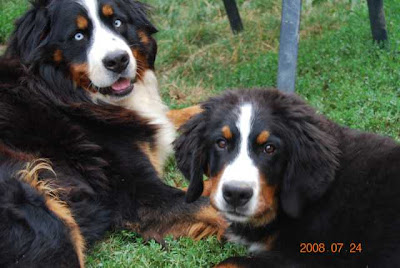

Bernese Mountain Dog
(Berner Sennenhund, Dürrbächler)
FCI-Standard No 45
Origin: Switzerland
Utilization:
Originally used as a guard and draught dog and for driving cattle in the Kanton Bern; today also multi purpose, companion and family dog
FCI-Classification:
Group 2 (Pinscher and Schnauzer type - Molossian type and Swiss Mountain and Cattle Dogs)
Section 3 (Swiss Mountain and Cattle Dogs)
Without working trial.
Brief historical summary
The Bernese Mountain Dog is a farm dog of ancestral origin which was used as a guard and draught dog and for driving cattle in the prealpine regions and in the midland areas around Bern. Originally he was named "Dürrbächler" according to the name of the hamlet and of the inn of Dürrbach, near Riggisberg, where this longhaired tricoloured farm dog was especially appreciated
In 1902, 1904 and 1907 subjects of this breed were exhibited at dog shows. In 1907 a few breeders of the region of Burgdorf decided to promote the pure breeding of this native dog by founding the "Schweizerische Dürrbach-Klub" and fixing the characteristic traits of the breed in a first standard. In 1910, at the invitation of the "Dürrbach-Klub", there were already 107 subjects shown by the farmers at this very special event.
From that day onward this dog, renamed "Bernese Mountain Dog" (following the example of other breeds of Swiss Mountain Dogs) became repidly known all over Switzerland and Southern Germany. Today the Bernese Mountain Dog is well known and appreciated all over the world as a companion and family dog thanks to its striking tricoloured coat and its great adaptibility.
General appearance
Longhaired tricoloured working dog, of above medium size, sturdily built, yet agile; well balanced in all parts.
Size:
Males 64 - 70 cm at withers, ideal size 66 - 68 cm
Females: 58 - 66 cm at withers, ideal size 60 - 63 cm
Temperament:
Self confident, attentive, vigilant, fearless in situations of every day life, good natured and devoted to his own people, self-assured and friendly towards strangers; of average and docile temperament.
Movement
Sound and balanced movement in all gaits covering a lot of ground; free stride reaching well out in front, with plenty of drive from behind; at the trot coming and going, legs moving forward straight and parallel.
Coat
Hair:
Long, smooth or slightly wavy.
Colour:
Jet black with rich tan markings on cheeks, over the eyes, on all four legs and on the chest, and with white markings as follows:clean white symmetrical markings on the head: blaze extending towards the nose on both sides to a muzzle band; the blaze should not reach the tan markings above the eyes, and the white muzzle band should not extend beyond the corners of the mouth moderately large, unbroken white markings on throat and chest
desirable: white feet, white tip of tail
tolerated: small white patch on nape of neck, small white anal patch.
Head:
strong; skull viewed from front and in profile very slightly rounded; facial-cranial depression (stop) well defined without being too pronounced; frontal furrow slightly marked.
Nose: black
Muzzle: strong, of medium length; nasal bridge straight
Lips: not much developed; well fitting to the jaws; with black pigmentation.
Mouth:
strong, complete dentition, scissor bite.
Eyes:
dark brown, almond shaped, with well fitting eyelids.
Ears:
triangular shape, slightly rounded at the tip, set high, medium sized, in repose hanging flat and close to the head.
Body:
compact and sturdy
Back: firm, straight and level
Loins: broad and strong
Rump: slightly rounded
Chest: broad and deep, reaching to the elbows; forechest well developed; chest and ribcage of wide-oval cross-section.
Belly: not tucked up.
Tail:
bushy, reaching at least to the hocks; hanging straight down when at rest; carried level with back or slightly above when moving.
Forequarters:
Rather wide apart, straight and parallel
Shoulders: shoulder-blades long, strong and well laid back, forming a not too open angle with the upper arm, well attached to the chest, well muscled
Pasterns: almost vertical (or very slightly oblique), firm
Feet:
short, round and tightly bunched; well arched toes.
Hindquarters:
Seen from the rear straight and not too narrow; hocks and feet neither turning in nor out; dewclaws must be removed
Thighs: rather long, strong, broad and well muscled, with well bent stifles
Hocks: strong, well angulated.
Faults
Any departure from the foregoing points should be considered a fault which should be penalized in proportion to its seriousness and importance:
light bone structure
undershot or overshot bite
absence of teeth other than 1 or 2 PM 1 (first premolar), M 3 (third molar) not to be considered
entropion, ectropion
sway back, rump higher than withers, sloping backline
curled tail, kink tail
distinctly curled coat
faults of colour and markings
absence of white on head
blaze too large and/or muzzle band reaching noticeably beyond the corners of the mouth
large white patch on nape of neck
white collar
white markings on forelegs reaching distinctly beyond half-way of pasterns ("boots")
disturbingly asymmetrical white markings on head and chest
black ticks and stripes on white of chest
"dirty" white (strong spots of pigmentation)
black coat with a touch of brown or red
weak temperament, aggressiveness.
Disqualifying faults:
split nose
wall eye
short coat, double coat (Stockhaar)
other than tricoloured coat
other than black main colour.
N.B. Males should have two apparently normally developed testicles fully descended into the scrotum.
